Unathi: Difference between revisions
| Line 216: | Line 216: | ||
Two of these guilds have expanded into large corporations that have found a lucrative method of gaining money from their wards. The '''Gukuzan''' and '''Kuhwinla''' Guilds coerce or persuade their wards to accepts contracts for NanoTrasen if they reach adulthood without being adopted. | Two of these guilds have expanded into large corporations that have found a lucrative method of gaining money from their wards. The '''Gukuzan''' and '''Kuhwinla''' Guilds coerce or persuade their wards to accepts contracts for NanoTrasen if they reach adulthood without being adopted. | ||
The '''Gukuzan''' clan is lead by a Priest Kiazoi, and he ensures that those that enter the care of his guild are given a proper religious education and instilled with the values of the church. Children raised by the Gukuzan are also taught valuable lessons in obedience and the importance of duty and respect to their betters. Its wards are moderately well-off and treated well, but the comforts of a happy childhood in the orphanage is rather soured by the fact everything from bedding, food, and even air conditioning are things each child has added to their growing debt. Gukuzan orphanages are scattered across Moghes and there are three on | The '''Gukuzan''' clan is lead by a Priest Kiazoi, and he ensures that those that enter the care of his guild are given a proper religious education and instilled with the values of the church. Children raised by the Gukuzan are also taught valuable lessons in obedience and the importance of duty and respect to their betters. Its wards are moderately well-off and treated well, but the comforts of a happy childhood in the orphanage is rather soured by the fact everything from bedding, food, and even air conditioning are things each child has added to their growing debt. Gukuzan orphanages are scattered across Moghes and there are three on [[Ouerea]]. They are all exclusively managed by a priest on the payroll of the Gukuzan. | ||
The '''Kuhwinla''' clan is lead by Guildmaster Ioaza Kuhwinla, an infamously frugal woman. She refuses to spend any more than she has to on her wards, meaning that those under her care are given the most basic of education. Children raised by her Guild are taught valuable lessons in thrift, obedience, and how to stretch meals to the absolute limit. Its wards are generally barely better than they would be on the street, but they live with a roof over their heads, semi-reliable food, a basic education, and their debt at the end of their life under the Kuhwinla is generally lower than it would be in other orphanages. Kuhwinla orphanages are in nearly every major Unathi city, and they are unique in that they are managed by matriarchs that answer to Ioaza. | The '''Kuhwinla''' clan is lead by Guildmaster Ioaza Kuhwinla, an infamously frugal woman. She refuses to spend any more than she has to on her wards, meaning that those under her care are given the most basic of education. Children raised by her Guild are taught valuable lessons in thrift, obedience, and how to stretch meals to the absolute limit. Its wards are generally barely better than they would be on the street, but they live with a roof over their heads, semi-reliable food, a basic education, and their debt at the end of their life under the Kuhwinla is generally lower than it would be in other orphanages. Kuhwinla orphanages are in nearly every major Unathi city, and they are unique in that they are managed by matriarchs that answer to Ioaza. | ||
Revision as of 09:33, 21 December 2017
| Unathi Lore Pages | ||
|---|---|---|
| Planets and Systems | Moghes · Ouerea · Uueoa-Esa · Notable Unathi Colonies · Gakal'zaal · Tret | |
| Factions | Izweski Hegemony · Unathi Guilds · Unathi Piracy · K'lax in the Izweski Nation · K'lax in the Wasteland · The Queendom of Sezk-Hakh · Free City of Vezdukh · Unathi in Dominia | |
| History | Unathi History · Contact War · Unathi Recent Events · Notable Unathi | |
| Religions | Sk'akh · Th'akh · Aut'akh · Si'akh | |
| Society and Culture | Unathi Entertainment · Unathi Honor · Unathi Military Structure · Unathi Crime And Enforcement · Unathi Educational Institutions · Unathi Spaceflight · Unathi Abroad · Zandiziite Games | |
| Regions of Moghes | Izweski Heartland · Tza Prairie · Southlands · Broken Coalition · Torn Cities · Zazalai Mountains · The Wasteland · The Viridis | |
| Lore Arcs | The Titan Rises Arc · New Blades, Old Wounds Arc · They Who Hath Become Lord Arc | |
| Unathi |
| U. Sapiens / Sinta'Unathi |
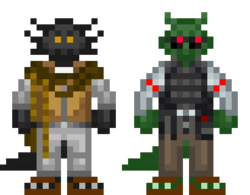 |
| Home System: Uueoa-Esa |
| Homeworld: Moghes |
| Language(s): Sinta'Unathi |
| Political Entitie(s): Izweski Nation / Izweski Hegemony |
Overview
The Unathi are a race of tall humanoid reptiles standing from six to seven feet tall on average, with females slightly smaller in stature. They possess a mixture of snake-like and crocodile-like features, resulting in hard and plate-like scales, excluding the ones on the belly, armpits and groin. Unathi live in their home system of Uueoa-Esa with their homeworld being Moghes. The planet's history can be summarized as being divided up between various hegemonies; names they give the most powerful Clans on Moghes throughout time. The Clan system is deeply entrenched in Unathi society, with everything else revolving around it. It forms a major part of their code of honour, which stresses the importance of martial abilities and loyalty to the Clan.
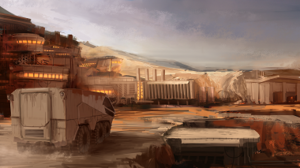
The Unathi code of honor also has them frown on ranged weapons, with many Unathi preferring melee combat.
After the Contact War, many Unathi which fled the planet through Nanotrasen-built shuttle ports slipped through the cracks and became slavers and raiders, gaining fearsome reputations.
Many Unathi in Nanotrasen find themselves working in security and engineering roles, but recently many have been proving themselves as competent surgeons and brilliant scientists, earning opportunities unheard of on Moghes.
To apply to be Unathi, apply here.
Heads of Staff
Unathi can be the following Heads of Staff:
- Head of Security
- Chief Medical Officer
- Head of Personnel
- Research Director
- Chief Engineer
- Internal Affairs Agent
Mechanics
- Unathi have slightly improved heat resistance, but increased sensitivity to cold.
- Unathi have improved unarmed melee attacks, which slash and have the possibility of knocking someone down.
- Unathi can devour monkeys, mice, spiders, carp, and other small mobs by clicking and dragging from the mob to themselves. The animal must hold still for it to work.
- Unathi hiss when speaking Tau Ceti Basic. You achieve this by typing multiple s's during speech. This can also be pronounced through x's if their accent is thick. "Thiss iss an exssample."
- Unathi have drastically reduced tolerance to alcohol. Ethanol is toxic to all Unathi.
- Unathi can only drink alcohol from drinks with butanol instead of ethanol. Butanol gets them drunk similar to ethanol but has no affect on other species.
- Unathi can safely eat carp and consume carpotoxin.
- Unathi can safely devour spiders and space bears.
- Unathi have the fastest sprint available to any species, but they have low stamina, meaning they can only sprint in short bursts.
Biology
Their average life expectancy is around sixty years for most Unathi. However, they tend to live for seventy or eighty years when given advanced medical care available to the other space-faring species. As a cold-blooded species, they suffer fatigue and even short comas when exposed to extremely low temperatures.
Since they are carnivorous species, their diet mostly consists of meat, though they do have a tolerance to some plants and fruits. However, they do not get any nutrition from plants, so they are mostly used as garnish or decoration.
The reproductive system of a Sinta'Unathi is very similar to that of Earth reptiles. Females lay eggs, with the average clutch being somewhere between one and three. They have an six month gestation period, after which they are laid in a humid, warm area. After two months, the fetus is fully developed and hatches from the egg. Unathi are born with their claws and ability to walk within hours of hatching. A Sinta'Unathi is considered an adult when they are 18 years old.
Biologically the Unathi of Moghes and Ouere are identical.
Physical Appearance
The Unathi as a species are born into one of four major scale color categories Red, Black, Orange-brown ("sand colored") and Green. Alternative colours are rare, with dark blue and even albino Unathi being reported in very small numbers. Traditionally these off-colored Unathi are met with prejudice, though some clans outside the Izweski may feel different. The typical healthy adult male Unathi weighs roughly 260 pounds.
The females differ from the males in that they generally have a shorter and more rounded snout. The typical healthy Unathi female weighs roughly 200 pounds.
Female Unathi tend to grow to be between 5'9" to 6'8.
Male Unathi tend to grow to be between 6'0" to 7'0".
Both sexes stand on plantigrade legs, jointed backwards, and have clawed feet and hands. They also have very long tongues, which may stretch up to a foot and a half long, forked just like a serpent's. In much the same manner as snakes, the Unathi can sample the air around them using their tongue. This tongue is usually black or an extremely dark red, and usually a foot in length.
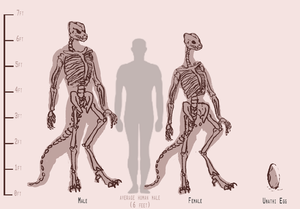
Social
Social Mannerisms
When speaking to superiors, it is considered formal and respectful to refer to them by the extended name of their command. A clan leader would be referred to by the name of their clan, a squad leader by the name of their squad. Intimate gestures between Unathi include twining necks, twining tails, and touching foreheads/muzzles. Hugging is usually considered something done by children, avoided by adults.
Unathi should always be addressed by their last name in most situations. It is offensive to use a Unathi's first name unless you are family or have a close friendship with them, but some Unathi are more permissive than others. In a situation where there are multiple Unathi with the same last name, it's generally accepted to just get more and more specific in your address to make it clear who you are speaking to.
For most Unathi being seen speaking to a Guwan is embarrassing. A woman associating with a Guwan is extremely improper and indecent, and they can lose social standing by doing so.
Baring the throat is the single most meaningful expression of trust in a lover or superior, often used as shows of extreme trust, compassion or admittance of shame, and within honorable contexts, clawing or biting the exposed throat is perfectly allowed.
Relationships for Unathi are, suffice to say, not one of equality, but responsibility. Males who request and admit attraction to a female will go to the male who is responsible for their well-being and tell them this, usually boasting or offering tributes to the female's caretaker as well. Trying to ignore the ritual of arranged marriage is a great insult to the female's clan, and at worst could lead to a blood feud and/or war. Divorces are also only possible by the male, with the female given no legal rights or ability to inherit property. However, a Unathi abusing or neglecting his wife is deeply insulting to the female's family and clan and can lead to dangerous feuds.
Emotional Displays
Unathi feel emotions just like humans feel, but with different cues. Irritation or heightened emotion is expressed by thumping the tail against the ground. Verbal exclamations are also common, as are short barks, rattling of the throat, or 'chuffing' (forceful exhalations of air from low in the throat). Anxious or worried Unathi might sway (similar to snakes), rattle the heavy scaling on their neck, hiss, or sample air more often than necessary. When cold, Unathi will usually bristle their scales in a manner analogous to human goosebumps. When overly warm, Unathi usually become sluggish and drowsy.
Language
Individual languages are described by the prefix 'Sinta' followed by the identity of its native speakers.
Speaking mannerisms remain the same when speaking Sinta or another language, but for a stylistic choice, avoid contractions like it's and they're, which would be it is and they are.
Sinta'Unathi
While Pre-Contact Moghes had hundreds of unique languages and their own histories, Sinta'Unathi has been and remains the primary language spoken by most Unathi. It is an evolution of an older Moghean trade language, Sinta'Izwe.
The written language has 30 letters, with 5 of them being vowels. The language is written left to right, though this was an attempt to emulate humanity, as informal Sinta'Unathi still write top to bottom.
Sinta'Azaziba
A language of Moghes consisting of a combination of spoken word and gesticulation. While waning since Moghes entered the galactic stage, it enjoys popular use by Unathi that never fell to the Hegemony's cultural dominance.
Sinta'Azaziba writing has 27 letters, 4 of which being vowels. The language is written top to bottom.
History of Sinta
Modern Sinta'Unathi began in the 1990's as the primary language of the Izweski Nation, and spread across the globe for merchants seeking to do business in foreign Kingdoms. It became the main language of global trade, and eventually began to trickle its way upwards to become the primary language of the upper classes. By the late 2100's the Izweski Hegemony passed several laws attempting to increase imperial nationalism in its extremely diverse population. All Hegemonic citizens were required to be fluent in the language, and speaking foreign languages in public carried threats of imprisonment. Imperial authorities also carried out mass-kidnappings of ethnic Unathi, raising the young in boarding schools that instilled in them proper Hegemony values and Sinta'Unathi language lessons. Children were often beaten if they were discovered speaking their native language.
The earliest forms of Sinta writing come in the form of hieroglyphs that scribes literally scratched onto wooden tablets with their talons, with the earliest dated around 600 CE. These early tablets were predominately inventory records, consisting of nouns and tally marks. As society grew more interconnected and complex, scribes and impatient merchants decided they had better things to do than spend hours making thousands of tally marks, so writing continued to evolve until taking their modern form.
One of the first things to go was literally scratching wooden tablets, with scribes eventually dipping their talons into pulped Peizi Berries, which left stubborn, persistent stains on almost anything it touched. This meant scribes or writers could be identified by having stained talons; a trend that became more style than practical after the printing press came into use. But even in modern times, Unathi that want to appear intellectual often paint their talons. However this has become embarrassing for Unathi as humans view it as girly, so it's become an embarrassing faux pas to be caught with stained or painted talons, leading to skyrocketing sales of pens across Unathi space.
Culture
Moghean
Moghean Unathi are traditional Unathi, with the planet being their homewold. Historically culture varies across Clans which exist on the planet, but some customs and norms arch over nearly all Unathi universally.
It is a social faux-pas to use a Unathi's first name if not family or extremely close to the Unathi in question. Generally a Unathi will tell someone when they feel comfortable with the person using their first name. It is also distressing to Unathi to touch their tail, or to touch them at all before introductions are undertaken.
Unathi place great emphasis on oral traditions. Writing and reading are seen as men's work, with most Unathi women discouraged or even banned from learning.
Outside the formal schools of the Untouched Lands, village and town shamans often remain the only source of education for many young unathi.
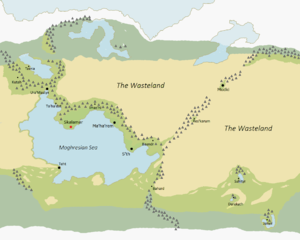
Ouerean
While the Unathi of Ouere follow most of the same social beliefs as their Moghean counterparts, they tend to be less volatile towards outsiders who are ignorant of their customs, especially since their world was formerly ruled by the Skrell and Humanity. The culture of humanity and Skrell have managed to influence Ouerean Unathi, embedding different cultural norms. There is a focus on individualism, with most Unathi being given the same chance as anyone else. There is still a struggle with a highly stratified society, but things are much more liberal than on Moghes.
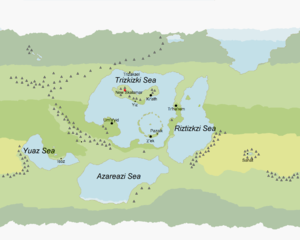
Many of the original colonists started as patriots to the Izweski Hegemony, but many soon found themselves disillusioned with the distant home world tearing itself apart in war. Many of them became enamored with human and Skrell culture and ideals of democracy, equality, and liberalism; finding themselves resentful of their old lives on Moghes. Reintegration into the Hegemony has proved difficult as both planets try to reconcile these cultural differences.
Ourean art, in contrast to Moghean pottery and dyed fabrics, has taken on inspiration from human and Skrell art. Many Ourean Unathi have become renowned glass makers and craftsmen. The greater access to human and skrell universities - many of which still operate on the planet - also give Ourean Unathi greater chances to specialize with human and Skrell systems.
Women
Women are very much a subjugated underclass in traditional Unathi society. The legal differences between Unathi women and "property" is vague. They are discouraged from reading or writing, can't join the military, and are expected to cook and clean the household while looking over the children of the clan. They legally cannot divorce from their husbands, and their marriages are often arranged by the male elders of their clan. They're political tools used to create alliances between Clans.
Women still do hold power in some ways. They are responsible for raising the children and can hold influence over their husbands. When married, their former clan can lose a lot of face or honor if she's mistreated or divorced. Entire wars have broken out over divorces or accusations that the husband is mistreating the female. Unathi women are also in charge of the education of Unathi children until they're 5 years old, when they go to formal schools. Outside the Izweski Hegemony on Moghes, women are often tasked with the education of their children until adulthood, aided only by the local shaman's teachings.
Religion
While various faiths exist on Moghes, many of which are as old as any other, there are two major religions of the Unathi that pervade in nearly every aspect of their lives. Th'akh and Sk'akh, both of which predominately focus on ancestor worship and connections with the spirit world. More information can be found here.
Politics
Moghes is divided between the Izweski Nation, which exists in the Untouched Lands, and the hundreds of other Clans and nations who claim their own land across the planet's surface. The only real difference in their political systems is the scale. Many of these other clans are modern nations or pre-industrial, ruled by various kings or leaders. However with the expansion of the uninhabitable Wasteland and the brutal decimation Izweski forces committed on foreign leadership many institutions of Non-Hegemony government across Moghes are rare or extremely fragile.

Izweski Nation
Izweski is lead by Clan Leader S’kresti Izweski, a 56 year old Unathi who ruled the country since he was 38 after his father Kitaskis Izweski, the previous Hegemon, died from liver failure at 61. He lives in the Izweski Citadel in Skalamar, and under him are the Lords who rule their own subjugated clans. They live in a feudal system, with the Lords usually being clan leaders or important clan members themselves who pledge themselves to Izweski in exchange for land and protection.
The Hegemon is the Emperor, and under him are the Overlords, who are the Kings. Under the Overlords are the Lords, who are then broken up between the Clan Lords, and then the Clan Leaders. Clan Leaders are a mostly ceremonial title and make up (usually) the eldest male ruler of a specific family clan.
After the death of his eldest son in a shuttle crash the Hegemony fell into a deep depression to the point of becoming comatose. In his place S'linzar Ickza, his eldest son in law, declared himself regent and heir to the empire. After a brief succesion crisis, Not'Zar Izweski, the second eldest son, took his place as the Regent and heir. Despite his severe physical handicap forcing him to walk with a cane, and the resulting assumption from the upper nobility that he is weak and incapable of ruling, Not'Zar Izweski has proven a shrewd diplomat, with many powerful allies within the government that keep his position tenuously secure.
Overlords rule an entire planet in the name of the Hegemon. Under them are Lords, who can rule huge tracts of land and multiple cities, or just a single city; there is no distinction between a Count and Duke level of Lordship like in most human feudalism.
There are two different kind of major lifestyles In Izweski. There is the city, which is ran by a Lord and a small council of lesser clans. City life is less harsh than life in the country, especially with opportunities provided with shuttle services to the rest of the galaxy.

Life in the rural areas is harsher, with cities being rare and life mostly determined by the size of a Clan's village and how well they can hunt, fish, or in desperate times, raid their neighbors. It's the traditional Unathi life, made harsher by the growing Wasteland encroaching on once fertile lands.
Ouerean
The Ouerean Government used to made up of a Colonial Government with a human Governor and Skrellian advisors and mayors. Since the Hegemony regained control of the planet, it is overseen by an Overlord, who is currently Tarkart Yiztek. The native Ourean unathi elders have created an administrative council to help rule under the Overlord, and there is an attempt to blend the law codes of the former Colonial rulers and ancient code of honour of the Moghean Unathi.
The planet is struggling economically as it deals with reintegration into the Hegemony as well as a growing refugee crisis. The Izweski on Moghes have been attempting to ship as many refugees from the Wasteland to Ourea as possible, causing the population to skyrocket. Many Ourean cities, modern and comparable to large cities in the 22nd century Earth, are now suffering with an explosive growth of slums.
Many humans still reside on Ourea, and the planet is much more mixed than Moghes. There is also difficulty in integrating the previous republican planet into the Unathi system of vassalage and appointment - many Representatives and mayors lost their positions.
History Overview
More in-depth information on the history of the Unathi can be found on their history section.
The history of the Unathi is predominately a history of each Hegemony that has existed throughout their history. There have only been three clans that have managed to create an empire worthy of the title Hegemony.
The Kres’ha’nor Hegemony lasted from roughly 920 CE - 1500 CE. It is most famous for being the first empire to dominate Moghes and creating what was then a modern feudal state. Their empire saw rise of walled cities, steel weapons, centralized taxation, and other innovations. It ended in a brutal succession war, with Moghes once again being shattered into hundreds of individual Kingdoms with no true global power.
In the 16th century the power of Guilds began to grow, forming an early form of capitalism. Guilds formed for bakers, butchers, grocers, millers, smiths, carpenters, weavers, mason, shoemakers, in fact, nearly every trade had its own guild. Standards such as just weights and measures evolved from the guilds, and guild inspectors would inspect shops to ensure rules were being followed. Guilds would help members that were sick, or in trouble, and would sometimes take care of families after the member died. This time also saw Guilds building the first major universities. While incredibly exclusive, these universities began to create a new era of specialized labor and intellectuals.
The 19th century saw rise of the Second Hegemony, ruled by the Sarakas Clan. Their clan ruled harshly, and forced technological advances into the cities and towns. In the 1930's they ruthlessly modernized their empire in The Great Endevour, spreading electricity, radio, paved roads, modern plumbing, and other modern innovations.
In 1994 the Izweski Clan violently deposed the Sarakas and slaughtered the entire surviving dynasty, declaring the Third Hegemony. After they won an incredibly destructive global war to defend their claim, the Izweski have ruled Moghes until modern times.
In 2433, a human exploration team discovered Moghes. Shortly after, first contact was made. Sol Alliance merchants and scientists flocked to Moghes, living under very careful observation and guard in Izweski cities. Skalamar, the second largest city in Izweski, became the first Unathi city to have a shuttleport constructed. Owned by NanoTrasen, it served to transport people to and from the planet’s surface.
The Contact War, which has more information here, was a cataclysmic global war that lasted from 2437 to 2449. The fighting was between two global powers, the Izweski Hegemony, and the Traditionalist Coalition. The war was fought over the very future of the Unathi and their relationship with the rest of the galaxy. The Izweski demanded Moghes submit to a one world government ran by themselves and embrace the influence of humanity. The Traditionalist Coalition rejected this. The war went nuclear on September 5th, 2439, causing immense suffering across Moghes and directly leading to the creation of The Wasteland, which is set to engulf Moghes within a hundred years.
Notable Information
‘Guwandi’
In the event that a Unathi becomes mortally ill, or finds themselves lacking the pride or honor to continue to live, or simply become tired of their existence undergo a ritualistic suicide and take the title of 'Guwandi' (which is translated to Gladiator/Galdium). They will give up their possessions to their clan leader and make their journey into the Moghes desert. The only things they keep are their weapons which they use to fight animals or other Unathi so that they may die in honorable combat. In the event that two of these Guwandi meet, they will first draw their weapons and adopt a passive stance, which is followed by them telling each other their stories in turn, as well as the reasons behind their choice of adopting the mantle of 'Guwandi' and how they wish their remains to be dealt with. When both sides understand the other, combat will begin with a mutual wish of luck that the more worthy of death lose with pride. The winner of the battle is responsible for taking care of the corpse in the way they were instructed to. Renouncing the deathseeking life of Guwandi isn't easy. Some may wish to return after having been granted a second outlook, or hope, after they had spent time wandering and risking their life. Their clan may see their decision as cowardly and refuse to accept them, or be overjoyed they had learned a lesson in their time.
The Guwan
In some cases when a Unathi is exiled from their clan, they do not take up the formal title of Guwandi. This can be through fear of death, unwillingness, or simple stubbornness. In this case, they are marked as 'Guwan' by their clan leader, and must take this as their last name. It is a variation on Guwandi, which is translated directly as 'exile'. Guwans are clanless Unathi, and form an underclass. Guwans find it difficult if not impossible to advance socially or politically, and in many cases are oppressed or mistreated by other Unathi who view them as troublemakers or criminals. The only way of returning to a clan after banishment as a Guwan is to be adopted back into the Clan, which happens very rarely.
On August 29th, 2459, the Lord-Regent Not'zar Izweski passed an edict that required clans to send a petition to an imperial court when they want to banish a clan member as a Guwan. The court must side with the petitioning Clan Leader or the Unathi in question is not marked as a Guwan. This has caused backlash as the courts have gained a reputation for being incredibly arbitrary in their decisions.
In the past, all orphans were automatically Guwan unless they are adopted into a Clan. This changed with yet another edict by Not'zar Izweski in December of 2459, which required all orphans, including adults still connected to their orphanage guild via debts or otherwise without parents, to take on the surname of that orphanage.
Many Guwan have been forced off of Moghes by their clans with the growing ease of space travel, and Nanotrasen has a long history of exploiting this subgroup of Unathi, coercing them into employment contracts.
Notably, Guwan are the only social class of Unathi allowed to serve in the personal guard of the Hegemon and his family. The strategy relies on the fact that the guwan of the Guwan Guard are despised and envied by decorated officers that would otherwise serve in traditional guard duties. They are socially isolated and unable to advance politically, which means that their survival depends on the safety of the Hegemon and his family, which means that they wouldn't try to launch a coup or replace the Hegemon without themselves being slaughtered. Similar to an old-Terran Janissary, they're a slave soldier, and unable to have children or hold any sort of political or military position.
If a Unathi is the last of his clan, or is otherwise estranged with no one to declare them Guwan, then a Unathi may still find themselves challenged by other rival clans who lay claim to this Unathi's land, titles, inheritance, or name. If a Unathi is unable or unwilling to defend their claims (which would involve lengthy court trials on Moghes) then they would be stripped of them and declared Guwan. This means that a Unathi hiding in human space can still be named Guwan if their past, or rivals, catch up with them.
Guwan are exclusively a criminal or otherwise dishonorable untouchable class, and it takes a lot to be labelled as one. If you want to simply play an orphan who is otherwise an upstanding Sinta, you can't be a Guwan!
Orphans and Orphanage Guilds
Orphans in the Hegemony in the past were all labelled as Guwans, but an edict by Not'zar Izweski in December of 2459 changed all that. Hatchlings, child, and teenage Unathi without parents are put in the care of one of the many orphanage guilds on Moghes. These are private run guilds with little to no government oversight. While they fufill a necessary social service in caring for Unathi that would otherwise be on the streets, orphanage guilds in the Hegemony are incredibly exploitative. Unknown to the children the guilds track all the expenses and charge their wards throughout their life until they turn 17, when they are presented with the bill and are forced to work to repay the crippling debt, and many can be trapped by the fact that their debt would fall on any prospective parents.
Two of these guilds have expanded into large corporations that have found a lucrative method of gaining money from their wards. The Gukuzan and Kuhwinla Guilds coerce or persuade their wards to accepts contracts for NanoTrasen if they reach adulthood without being adopted.
The Gukuzan clan is lead by a Priest Kiazoi, and he ensures that those that enter the care of his guild are given a proper religious education and instilled with the values of the church. Children raised by the Gukuzan are also taught valuable lessons in obedience and the importance of duty and respect to their betters. Its wards are moderately well-off and treated well, but the comforts of a happy childhood in the orphanage is rather soured by the fact everything from bedding, food, and even air conditioning are things each child has added to their growing debt. Gukuzan orphanages are scattered across Moghes and there are three on Ouerea. They are all exclusively managed by a priest on the payroll of the Gukuzan.
The Kuhwinla clan is lead by Guildmaster Ioaza Kuhwinla, an infamously frugal woman. She refuses to spend any more than she has to on her wards, meaning that those under her care are given the most basic of education. Children raised by her Guild are taught valuable lessons in thrift, obedience, and how to stretch meals to the absolute limit. Its wards are generally barely better than they would be on the street, but they live with a roof over their heads, semi-reliable food, a basic education, and their debt at the end of their life under the Kuhwinla is generally lower than it would be in other orphanages. Kuhwinla orphanages are in nearly every major Unathi city, and they are unique in that they are managed by matriarchs that answer to Ioaza.
These two surnames are the only ones you may take if you play a non-guwan orphan Unathi on the Aurora station!
Diet and Cuisine
Unathi dishes are mostly, or all made up of meat, eggs, and fish, as they are a carnivorous species. It may be cooked, or even still raw and bleeding. Vegetables in meals are often just for decoration or flavor, but by no means ever make up the majority of the dish. Unathi do not take any nutritional value from plant matter, only from meat. Desert flowers may also be placed on the plate to make it seem well presented, and are also edible. The tools Unathi use to eat are very unorthodox to humans.
Important meals like dinner and breakfast are meant to be consumed while surrounded by family and/or friends, and as such there are no designated utensils. Food will be cut and picked up in strips or portions with their claws. Females are expected to do the cooking.
To support their civilization, fishing has developed on a scale similar to human agriculture. Since the War, fishing yields have fallen, and hunger has become a fact of life for many Unathi.







